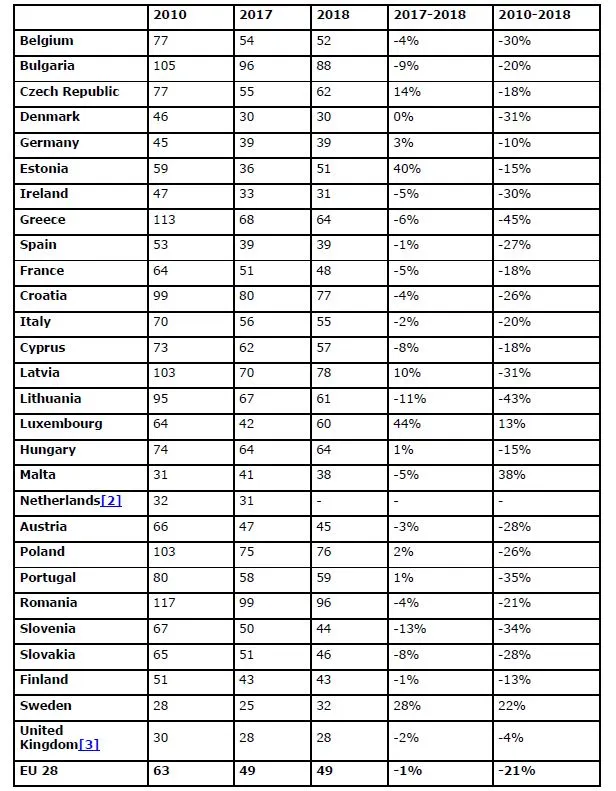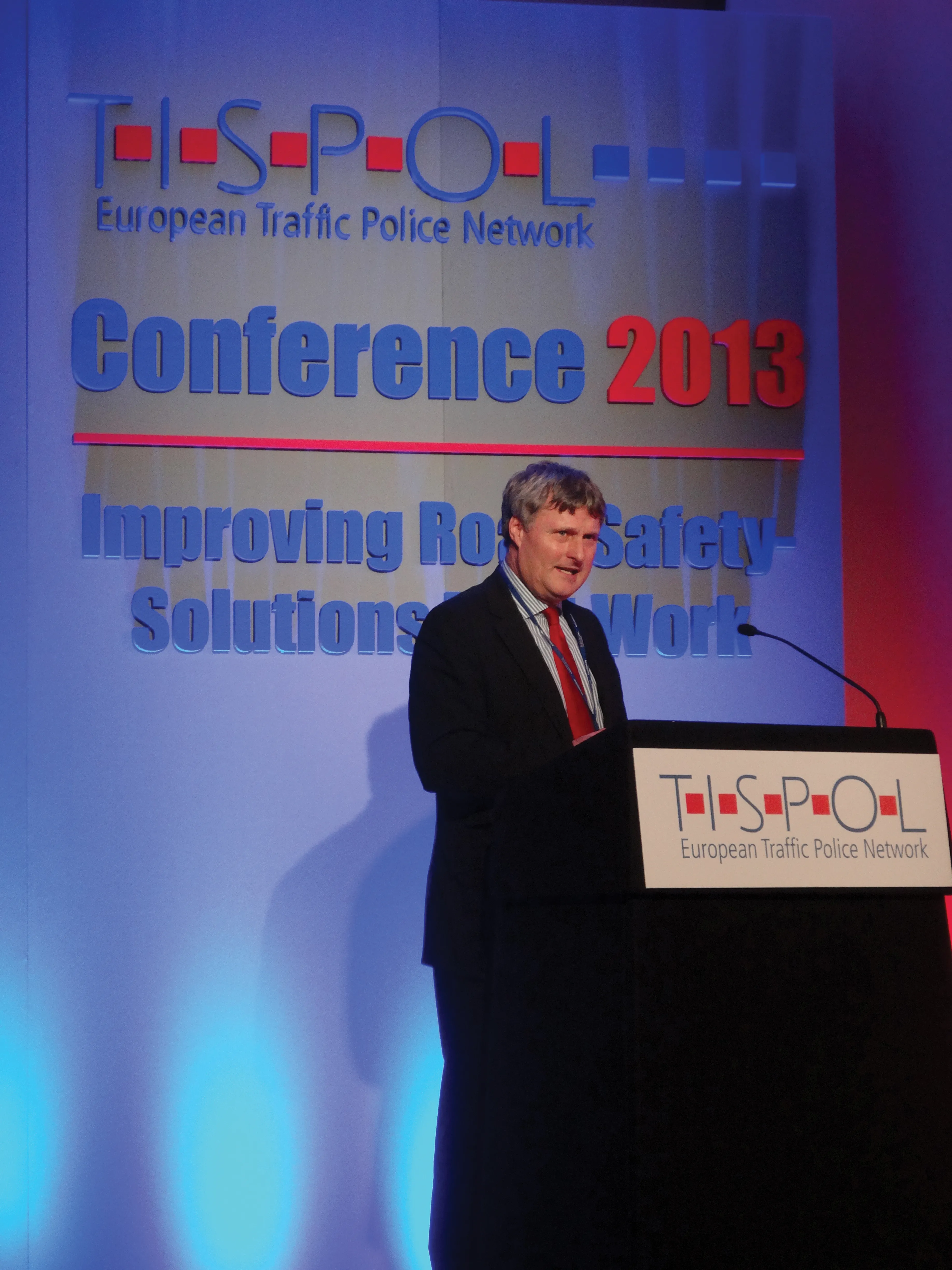In 2013, 7,600 people died in road traffic while cycling or walking in European Union (EU) countries – the equivalent of a commercial airliner full of passengers being lost every week Because of this risk of death, the European Transport Safety Council (ETSC) wants vehicle manufacturers and local authorities to pay special attention to improving safety for cyclists, walkers and pedestrians. In a new report, the ETSC said the numbers being killed are falling more slowly than those for vehicle occupants. Over
July 10, 2015
Read time: 6 mins
In 2013, 7,600 people died in road traffic while cycling or walking in European Union (EU) countries – the equivalent of a commercial airliner full of passengers being lost every week
Because of this risk of death, the1197 European Transport Safety Council (ETSC) wants vehicle manufacturers and local authorities to pay special attention to improving safety for cyclists, walkers and pedestrians. In a new report, the ETSC said the numbers being killed are falling more slowly than those for vehicle occupants.
Over the past 12 years, 138,400 pedestrians and cyclists were killed in road traffic. However, in the past decade, deaths among pedestrians fell by 41% and deaths among cyclists fell by 37%, while vehicle occupant deaths fell by 53%.
In 2014, nearly 25,700 people – an average of 500 a week - were killed in the European Union as a consequence of road collisions. This was a negligible drop of 1% on 2013. The drastic slowdown in progress puts at risk the region’s target of halving road deaths by 2020.
The risk of being killed in traffic as a pedestrian is lowest in the Netherlands and Scandinavia and about six times greater in Latvia, Lithuania, Poland and Romania. However, Latvia and Lithuania also have the fastest reductions in risk.
The authors cite counter-intuitive evidence amounting to a ‘safety in numbers’ effect. The more cyclists and walkers there are, the lower the risk that they will become an accident statistic. The theory is that motorists become used to sharing the road.
ETSC said the2465 European Commission has repeatedly promised to introduce a strategic target to cut the number of serious injuries on European roads but there is only an EU target to reduce deaths.
The European Union has a target of halving road deaths over the 10 years to 2020. But figures released by the European Commission (EC) in March showed that last year progress slowed markedly.
“Despite the health and environmental benefits, people who cycle and walk are not getting a fair share of improvements in road safety in Europe,” said Antonio Avenoso, executive director of ETSC. “This year, the EU has a very powerful weapon at its disposal, namely the review of safety requirements for new vehicles. It should not shy away from mandating the changes that can save the most lives.”
ETSC said the EU should upgrade the pedestrian protection tests that form part of the ‘type approval’ process that all new vehicles sold on the EU market must undergo. The tests should also take into account the need to better protect cyclists when they are hit by a car.
In addition, new vehicles should be fitted with an over-ridable system for helping drivers stick to speed limits, known as Intelligent Speed Assistance (ISA). Some car makers already offer such a system as an optional extra. ETSC is also calling for mandatory safety requirements for heavy goods vehicles to improve visibility and prevent vulnerable road users from being run over.
At the national level, the report recommends that local authorities introduce 30km/h zones in residential areas and areas heavily used by pedestrians and cyclists. Germany recently announced that it would make it easier for local authorities to introduce 30km/h zones near schools on main roads.
The risks of being killed as a pedestrian or as a cyclist are least in childhood and rise progressively through an adult’s life. The report also said that urban planning should be based on a hierarchy of road users where pedestrians, cyclists and public transport are prioritised.
A major new study published in April for the European Commission identified a range of vehicle safety technologies suitable for mandatory fitting as part of the review of EU vehicle safety legislation. The report, carried out by consultants TRL, names technologies including Intelligent Speed Assistance and Automated Emergency Braking as ‘feasible in terms of the technology required’, already available on the market and offering a positive benefit-cost ratio.
Top offences that road users would like to see police officers tackle include mobile phone use at the wheel – voted by 72%, drink- and drug-driving – voted by 65%, aggressive and angry drivers – voted by 50%, and tailgating drivers – voted by 42%.
With more than 3,064 motorists killed or seriously injured in 2013 as a result of speeding, tackling speed-related offences also remains a major priority for drivers. According to 64% of survey respondents, one of the best ways to confront the issue is by ensuring that there are more traffic police officers on all major urban roads.
In the United Kingdom, the5125 Institute of Advanced Motorists (IAM) is urging the recently elected Conservative Government to boost efforts to promote road safety by giving targeted enforcement a higher priority.
With preliminary figures for 2014 showing an increase in deaths and injuries on UK roads, IAM urged the government to make road traffic policing a priority for police forces and commissioners in England and Wales.
The call follows a survey conducted by the IAM throughout April in which 2,703 people participated. Despite years of government cutbacks and police budgets continuing to be stretched, over 45% of respondents voted for an increase in the number of police officers in marked vehicles to enforce traffic laws.
With more than 3,064 motorists killed or seriously injured in 2013 as a result of speeding, tackling speed related offences also remains a major priority for drivers. According to 64% of survey respondents, one of the best ways to confront the issue is by ensuring that there are more traffic police officers on all major urban roads.
With reference to drink-driving alone, research from the National Police Chiefs’ Council (NPCC) has found that young drivers aged from 20 to 25 are most likely to be caught driving under the influence of alcohol. About 44% of respondents agree that a consultation is needed to reflect growing support for a lower limit following Scotland’s new drink-drive legislation from 80mg to 50mg limit, which came into effect on 5 December.
Besides seeing more traffic police officers on our roads, many road users believe that the police should be granted more powers. For example, 45% of respondents support this.
Nearly half of respondents said police should have more discretion to breath test based on where drivers are likely to be driving after drinking, for example, near pubs and clubs.
IAM’s chief executive officer, Sarah Sillars, said the UK Government cannot afford to be complacent about road safety. “A lot more needs to be done to address major road offences through the enforcement of existing legislation and full use of police powers,” she said.
“IAM supports an increase in the number of high-profile road-policing officers and a zero-tolerance approach to the enforcement of traffic laws. Where drivers are failing to live up to the required standards they must be given access to a wider range of targeted retraining courses that refresh their skills. These include the IAM drink-drive rehabilitation course, educational campaigns targeting young drivers and the IAM Skill for Life course, which help existing drivers to improve their skills and give them greater awareness of other road users.”
Because of this risk of death, the
Over the past 12 years, 138,400 pedestrians and cyclists were killed in road traffic. However, in the past decade, deaths among pedestrians fell by 41% and deaths among cyclists fell by 37%, while vehicle occupant deaths fell by 53%.
In 2014, nearly 25,700 people – an average of 500 a week - were killed in the European Union as a consequence of road collisions. This was a negligible drop of 1% on 2013. The drastic slowdown in progress puts at risk the region’s target of halving road deaths by 2020.
The risk of being killed in traffic as a pedestrian is lowest in the Netherlands and Scandinavia and about six times greater in Latvia, Lithuania, Poland and Romania. However, Latvia and Lithuania also have the fastest reductions in risk.
The authors cite counter-intuitive evidence amounting to a ‘safety in numbers’ effect. The more cyclists and walkers there are, the lower the risk that they will become an accident statistic. The theory is that motorists become used to sharing the road.
ETSC said the
The European Union has a target of halving road deaths over the 10 years to 2020. But figures released by the European Commission (EC) in March showed that last year progress slowed markedly.
“Despite the health and environmental benefits, people who cycle and walk are not getting a fair share of improvements in road safety in Europe,” said Antonio Avenoso, executive director of ETSC. “This year, the EU has a very powerful weapon at its disposal, namely the review of safety requirements for new vehicles. It should not shy away from mandating the changes that can save the most lives.”
ETSC said the EU should upgrade the pedestrian protection tests that form part of the ‘type approval’ process that all new vehicles sold on the EU market must undergo. The tests should also take into account the need to better protect cyclists when they are hit by a car.
In addition, new vehicles should be fitted with an over-ridable system for helping drivers stick to speed limits, known as Intelligent Speed Assistance (ISA). Some car makers already offer such a system as an optional extra. ETSC is also calling for mandatory safety requirements for heavy goods vehicles to improve visibility and prevent vulnerable road users from being run over.
At the national level, the report recommends that local authorities introduce 30km/h zones in residential areas and areas heavily used by pedestrians and cyclists. Germany recently announced that it would make it easier for local authorities to introduce 30km/h zones near schools on main roads.
The risks of being killed as a pedestrian or as a cyclist are least in childhood and rise progressively through an adult’s life. The report also said that urban planning should be based on a hierarchy of road users where pedestrians, cyclists and public transport are prioritised.
A major new study published in April for the European Commission identified a range of vehicle safety technologies suitable for mandatory fitting as part of the review of EU vehicle safety legislation. The report, carried out by consultants TRL, names technologies including Intelligent Speed Assistance and Automated Emergency Braking as ‘feasible in terms of the technology required’, already available on the market and offering a positive benefit-cost ratio.
Top offences that road users would like to see police officers tackle include mobile phone use at the wheel – voted by 72%, drink- and drug-driving – voted by 65%, aggressive and angry drivers – voted by 50%, and tailgating drivers – voted by 42%.
With more than 3,064 motorists killed or seriously injured in 2013 as a result of speeding, tackling speed-related offences also remains a major priority for drivers. According to 64% of survey respondents, one of the best ways to confront the issue is by ensuring that there are more traffic police officers on all major urban roads.
More traffic police needed
In the United Kingdom, the
With preliminary figures for 2014 showing an increase in deaths and injuries on UK roads, IAM urged the government to make road traffic policing a priority for police forces and commissioners in England and Wales.
The call follows a survey conducted by the IAM throughout April in which 2,703 people participated. Despite years of government cutbacks and police budgets continuing to be stretched, over 45% of respondents voted for an increase in the number of police officers in marked vehicles to enforce traffic laws.
With more than 3,064 motorists killed or seriously injured in 2013 as a result of speeding, tackling speed related offences also remains a major priority for drivers. According to 64% of survey respondents, one of the best ways to confront the issue is by ensuring that there are more traffic police officers on all major urban roads.
With reference to drink-driving alone, research from the National Police Chiefs’ Council (NPCC) has found that young drivers aged from 20 to 25 are most likely to be caught driving under the influence of alcohol. About 44% of respondents agree that a consultation is needed to reflect growing support for a lower limit following Scotland’s new drink-drive legislation from 80mg to 50mg limit, which came into effect on 5 December.
Besides seeing more traffic police officers on our roads, many road users believe that the police should be granted more powers. For example, 45% of respondents support this.
Nearly half of respondents said police should have more discretion to breath test based on where drivers are likely to be driving after drinking, for example, near pubs and clubs.
IAM’s chief executive officer, Sarah Sillars, said the UK Government cannot afford to be complacent about road safety. “A lot more needs to be done to address major road offences through the enforcement of existing legislation and full use of police powers,” she said.
“IAM supports an increase in the number of high-profile road-policing officers and a zero-tolerance approach to the enforcement of traffic laws. Where drivers are failing to live up to the required standards they must be given access to a wider range of targeted retraining courses that refresh their skills. These include the IAM drink-drive rehabilitation course, educational campaigns targeting young drivers and the IAM Skill for Life course, which help existing drivers to improve their skills and give them greater awareness of other road users.”








